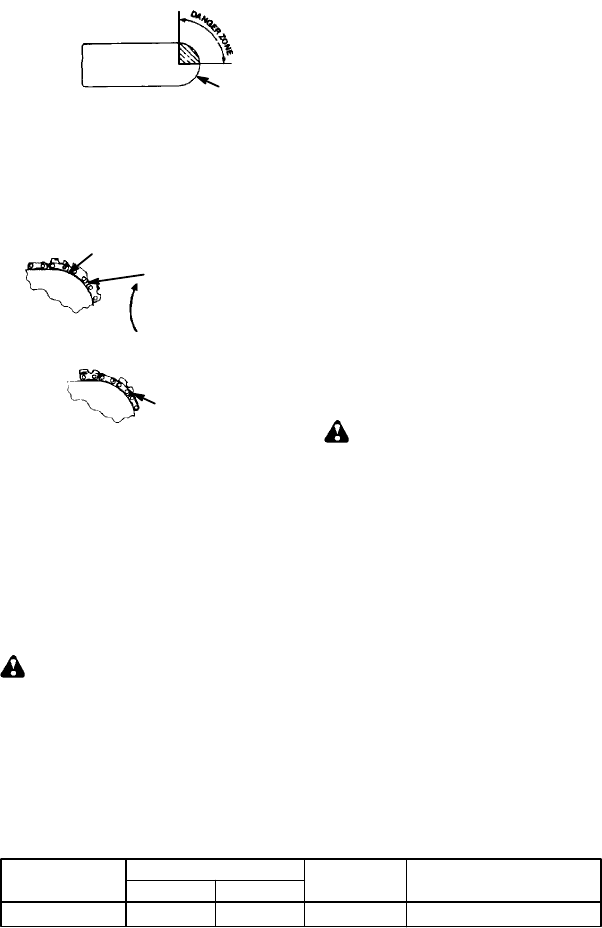
5
Symmetrical Guide Bar
Large Radius Tip
S Low--Kickback Chain, designed with a
contoured depth gauge and guard link
which deflect kickback force and allow
wood t ogradually rideintothe cutter.Low--
Kickback Chain has met kickback per-
formance requirements when tested on a
representative sample of chain saws be-
low 3.8 cubic inch displacement specified
in ANSI B175.1.
Low--- Kickback
Chain
Not a Low ---Kickback Chain
Can Obstruct Material
Contoured Depth Gauge
Elongated Guard Link
Deflects
kickback force
and allows wood
to gradually ride
Into cutter
S Front Hand Guard, designed to reduce the
chance of your left hand contacting the chain
if your hand slips of f the front handlebar .
S Position of front and rear handlebars, de-
signed withdistancebetween handlesand
“in-line” with each other. The spread and
“in-line” position of the hands provided by
this design work together to give balance
and resistance in controlling the pivot of
the saw back toward t he ope rator if kick-
back occurs.
CHAIN BRAKE AND CKA ANGLE
S Chain Brake, designed tostop the c hainin
the e vent of kickback.
WARNING: WE DO NOT REP-
RESENT AND YOU SHOU LD NOT AS-
SUME THAT THE CHAIN BRAKE WILL
PROTECT YOU IN THE EVENT OF A
KICKBACK. Kickback is a lightning fast ac-
tion which throws the bar and rotating chain
back and up toward the operator. Kickback
can be caused by allowing contact of thebar
tip in the danger zone with any hard object.
Kickbackcanalsobecausedby pinchingthe
saw chainalongthetopof theguide bar. This
action may push the guide bar rapidly back
toward the operator. Either of these events
may cause you to lose control of the saw
which could result in serious injury or even
death. DO NOT RELY UPON ANY OF THE
DEVICES BUILT INTO YOUR SAW. YOU
SHOULD USETHESAW PROPERLYAND
CAREFULLY TO AVOID KICKBACK. Re-
duced--kickback guide bars and low--kick-
back saw chains reduce the chance and
magnitude of kickback and are recom-
mended. Your saw hasa lowkickback chain
and bar as or iginal equipment. Repairs on a
chain brake should be m ade by an autho-
rized servicing dealer. Take your unit to the
place of purchase if purchased from a ser-
vicing dealer, or to the nearest authorized
master service dea ler.
S T ip contact i n somecases maycause alight-
ning fast reverse REACTION, kicking the
guide bar up and back toward the operator .
S Pinching thesaw chain alongthetop ofthe
guide bar may push the guide bar rapidly
back toward the operator.
S Either ofthese reactions may c ause y outo
lose control of the saw which could result
in serious injury.Do not rely exclusively
uponthesafety devices builtinto y oursaw.
WARNING: Computed kickback
angle (CKA) listed on your saw and listed in
the CKA table below represents angle of
kickback your bar and chain combinations
will have when tested in accordance with
CSA andANSIstandards. Whenpurchasing
replacement ba r and chain, considerations
should b e given to the lower CKA values.
Lower CKA values represent safer anglesto
the user, higher values indicate more angle
and higher kick energies. Computed angles
represented in the non-activated column in-
dicate total energy and angle associated
without activation of the chain brake during
kickback. Activated angle represents chain
stopping time relative to activation angle of
chain brake and resulting kick angle of saw.
In all cases lower CKA values represent a
safer operating environment for the user .
The following guide bar and chain combina-
tions meet kickback requirements of CSA
Z62.1, Z62.3, & ANSI B175.1 when used on
saws listed in this manual. Use of bar and
chain combinations oth er t hanthose listed is
not recommended and may not meet the
CKA requirements per standard.
Computed kickback angle (CKA) Table
BAR
P/N
Length
CHAIN P/N
MODEL
952044418 952051548
14_
CKA without chain brake
SM4018
18″
NOTE: If this saw i s to b e used for comm er-
cial logging, a chain brake is required and shall
not be removed or otherwise disabled to com-
ply with Federal OSHA Regulations for Com-
mercial Logging.
SAFETY NOTI CE: Exposure to vibrations
through prolonged use of gasoline powered
hand tools could cause blood vessel or nerve
damage in the fingers, hands, and joints of
people prone to circulation d isorders or
abnormal swellings. Prolonged use in cold
weather has been linked to blood vessel


















